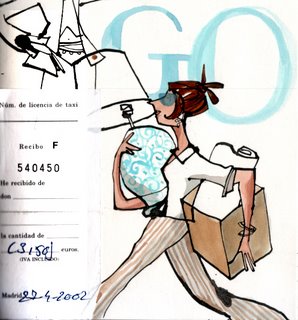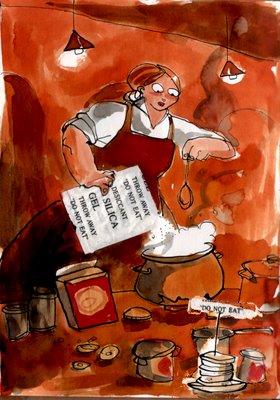
Bean soups are the true staple of the spanish kitchen. Don´t be fooled by books on tapas or Ferran Adria´s bubblebath creations. When push comes to shove, it´s beans you´ll be given. If you´re not given garbanzos or lentils, that is.
I used to hate the bean soup at school, a pale, lumpy gloop with small slices of orange chorizo floating wanly around, so for years I never ate it, never mind cooking it. But by and by the memory of the horrible versions began to fade, and I had occasion to try some very good bean soups, fabadas and such.
However, reading the literature, it was clear to me from the beginning that making your own pot of fabada makes no sense. What with locating the fabes, soaking them, simmering them while standing anxioiusly over the pot, ready to break the boil with cold water every now and then, it adds up to many hours. You might as well drive to Asturias and back. At least the scenery´s pretty.
I tried the dried bean thing a couple of times, but you know what? I´ve decided it´s environmentally unsound to waste so much fuel. Beans for twenty, yes, but for two? Five hours of fire? No way. Plus, it´s a complete pain in the neck.
Enter the jar of beans. The so excellent jar of beans. I don´t know how the case may be elsewhere, but here we have beans of great quality, lots of choice, and a great price. A lowly jar will cost almost nothing, and a gourmet version, organic, preservative free, not much more.
A basic 500 gr. jar makes a beautiful pot of soup for two in less than half an hour, and is a good way of getting rid of any floating population of vegetables you may have around. There are many ways to go with this, but I usually veer towards the Italian in my bean soups. Doubtless to stray as far as possible from the kind I ate (or didn´t) at school.
Deeply unpatriotic bean soupStart off with a
sofrito. Actually, let´s not even pretend, and call it
sofritto. Put a chopped onion in olive oil, and when it´s softened, add garlic, carrot and celery, chopped as fine as you like (
panceta or bacon are very good here, and there´s nothing to stop you from frying some good chorizo at the beginning, and letting the whole thing take on a golden tint. You´d better add some pepper, then, green for true Spanishness). Sweat it for then minutes or so, and then add grated tomato, if fresh, or squashed tomatoes from a tin. A couple will do.
Leave that for five more minutes, and then add a jar of beans, white, brown or black. Today I used
pochas, from La Rioja. If they´re good beans, the liquid in the jar will be the water they were boiled in, and taste very good. If it doesn´t then just drain, and add a little stock to the pot, about a cup, and a bay leaf.
I used to add a stock cube, but I´ve lately learnt a rather shocking trick,
here. A splash of barbecue sauce. I know, it sounds gross, but I promise, it gives an undetectable but really really good kick, smoky and sweet.
Leave to simmer for ten minutes, and then see how you go about the texture. With so little liquid, it´s quite thick, what we call a
potaje, but you may want to add more water and make it soupy.
Add quite a lot of fresh chopped parsley, serve in deep bowls, drizzle with chili oil, and dust with grated parmesan (there I go again).














